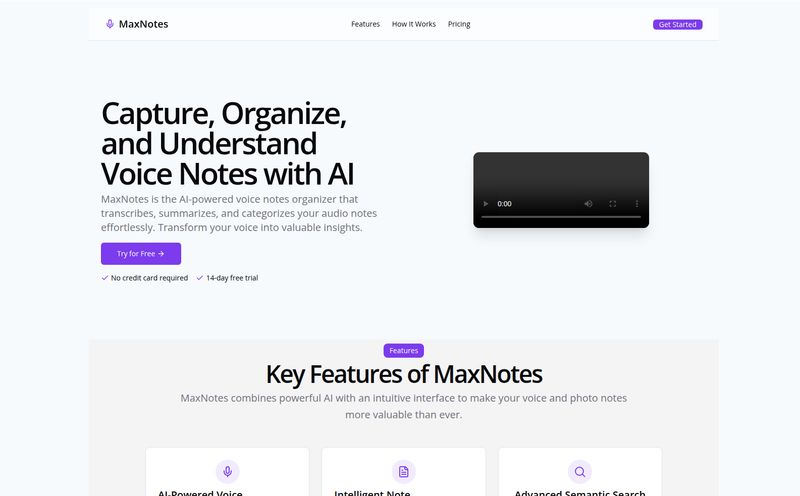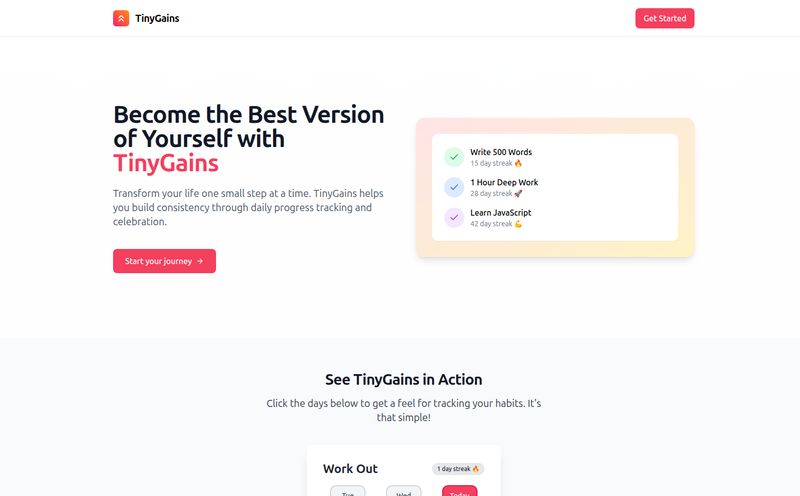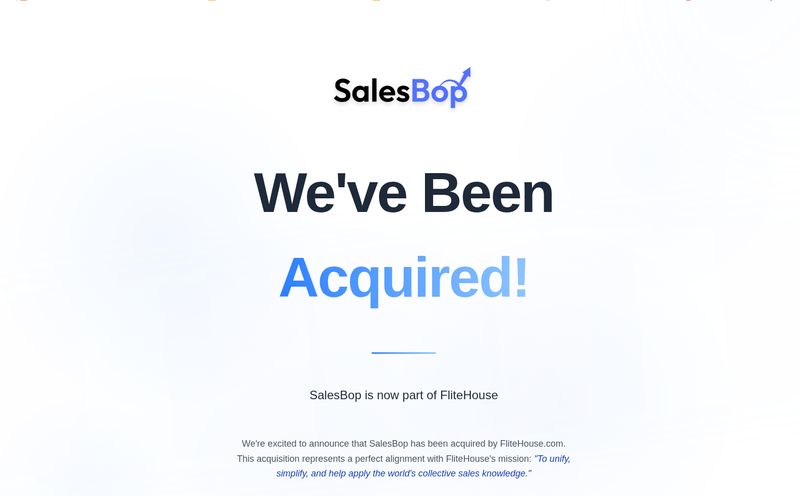How many of you have a desktop folder named 'Random Ideas' that looks like a digital garage sale? Or a notes app filled with half-baked thoughts, single-word prompts, and links you swore you'd check later? My hand is so high it's in the stratosphere. For years, I’ve been a die-hard fan of sprawling whiteboards and a rainbow of sticky notes. The process is cathartic, but the result? Often, it's a beautiful, chaotic mess that’s a nightmare to digitize and share. It's the classic content creator's dilemma: you have a storm of ideas, but wrangling them into a coherent strategy feels like herding caffeinated cats.
So, when another “AI-powered solution” landed on my radar, I was skeptical. We're bombarded with them daily, right? But this one, called AflowMind, promised something that hit close to home: turning jumbled ideas into clean, beautiful mind maps just by talking to it. Or, well, typing in plain English. No more dragging boxes, no more fighting with connector lines. I had to give it a shot.

Visit AflowMind AI
So, What's the Big Deal with AflowMind?
At its core, AflowMind is an AI mind mapping application. But that description feels a little… beige. It doesn’t capture the magic. Think of it less like a piece of software and more like a brainstorming assistant. You throw a concept at it, say, "Create a mind map for a Q3 content marketing plan for a new vegan bakery." And instead of a blank canvas, it starts building a logical structure right in front of you. It’s wild.
It uses what it calls “intelligent creation” and “intelligent text analysis.” Fancy terms, but in practice, it means the AI understands context. It doesn’t just make a box; it suggests sub-topics, organizes them into logical branches, and helps you see the connections you might have missed. For someone who lives and breathes topic clusters and content pillars, this was immediately intriguing.
The Things I Actually Liked (A Lot)
I'm a tough critic when it comes to tools that are supposed to improve my workflow. Most just add another layer of complexity. But AflowMind surprised me. Here's the stuff that genuinely stood out.
You Can Just Talk to It
The natural language interaction is the star of the show. I didn't have to learn a bunch of commands or click through a dozen menus. I just started typing. "Add a branch for social media campaigns, with sub-points for Instagram, TikTok, and Facebook." Done. "Change the color scheme to something more earthy." Poof. This conversational approach removes so much friction. It keeps you in the creative flow state instead of pulling you out to fiddle with formatting. It feels like teh future, honestly.
From Brain-Dump to Beautiful in Seconds
I’ve wasted more time than I'd like to admit trying to make my mind maps look presentable for clients. Aligning boxes, picking colors, making sure it doesn't look like a toddler's scribble. AflowMind's AI handles the heavy lifting. The intelligent creation is fast—scary fast. You give it a seed idea, and it populates a map that looks clean and professional from the get-go. With a bunch of themes and color palettes built in, you can get a shareable, client-ready visual in a fraction of the time.
It Plays Nice with Others
A tool is only as good as its ability to integrate into your existing workflow. AflowMind gets this. It supports a bunch of export formats (PNG, PDF, SVG, etc.), which means you can easily drop your mind map into a presentation, a strategy doc, or a Slack channel. Even better, it supports real-time collaboration. My team and I were able to jump into the same map and brainstorm together, seeing each other's changes live. No more "Hey, can you send me the latest version?" nightmares. This is a huge win for remote teams.
Keeping It Real: The Not-So-Perfect Parts
No tool is perfect, right? And I wouldn't be giving you an honest review if I didn't mention the potential downsides. My main hesitation comes down to two things.
First, as with any freemium model, the free version is likely a taste test. It's generous enough to let you see what the platform can do, but I suspect heavy users will hit a wall and need to upgrade. That's just business, but it's something to be aware of.
My other, more philosophical, concern is the reliance on AI. The AI is brilliant for getting started and structuring thoughts. But sometimes, the most creative breakthroughs come from the mess. From a weird, illogical connection you make manually. By letting the AI handle all the organization, you might lose some of those happy accidents. It's a trade-off: speed and neatness versus organic, chaotic discovery. For most business applications, I'd say speed wins, but it's something I think about.
What's the Damage? A Look at AflowMind's Pricing
Alright, let's talk brass tacks. The pricing structure is refreshingly simple, which I appreciate. You’ve got three main options.
| Plan | Cost | Best For |
|---|---|---|
| Free | $0 / Lifetime | Trying out the basics and seeing if it fits your style. |
| Monthly | $6.99 / Month | Individuals or freelancers with project-based needs. |
| Yearly | $59.99 / Year (works out to $4.99/mo) | Dedicated users, teams, and anyone looking for the best value. |
In my opinion, the value here is pretty solid. Less than a fancy cup of coffee per month on the yearly plan for a tool that could genuinely save you hours of work? That's a pretty easy yes for me. For agencies or content teams mapping out complex strategies, the ROI is a no-brainer.
Frequently Asked Questions About AflowMind
Is AflowMind actually free?
Yes, there is a lifetime free plan. It’s designed to let you get a feel for the tool, but for more advanced features and unlimited use, you’ll probably want to look at the paid plans.
What kind of files can I export my mind maps as?
AflowMind supports multiple export formats, including common ones like PNG, PDF, and SVG. This makes it easy to use your maps in other documents and presentations.
Can I use this with my team?
Absolutely. The real-time collaboration feature is one of its biggest strengths. You and your team can work on the same mind map simultaneously from anywhere.
How smart is the AI, really?
It's surprisingly good. It's not just creating boxes; it understands semantic relationships. If you're mapping a marketing funnel, it will likely suggest logical stages like Awareness, Consideration, and Conversion. It's an excellent starting point that you can then refine.
Is it better than just using a pen and paper?
That's personal preference! Pen and paper offer total freedom. AflowMind offers speed, structure, collaboration, and easy sharing. I’d say it’s not a replacement for that initial creative spark, but it’s a far better tool for developing that spark into a workable plan.
The Final Verdict: Is AflowMind Worth It?
After spending some quality time with it, I’m genuinely impressed. AflowMind isn't just another mind mapping tool; it’s a legitimate workflow accelerator. It successfully bridges the gap between chaotic brainstorming and structured planning.
If you're a content creator, a marketer, an SEO professional, a project manager, or even a student trying to organize research, this tool is worth a serious look. It smooths out the most tedious parts of idea organization and lets you focus on what actually matters: the ideas themselves. It's earned a spot in my digital toolkit, and I have a feeling that my 'Random Ideas' folder might finally start to get a little cleaner.
References and Sources
- AflowMind Official Pricing Page
- HubSpot's Guide to Brainstorming Techniques - for those interested in the theory behind the practice.



